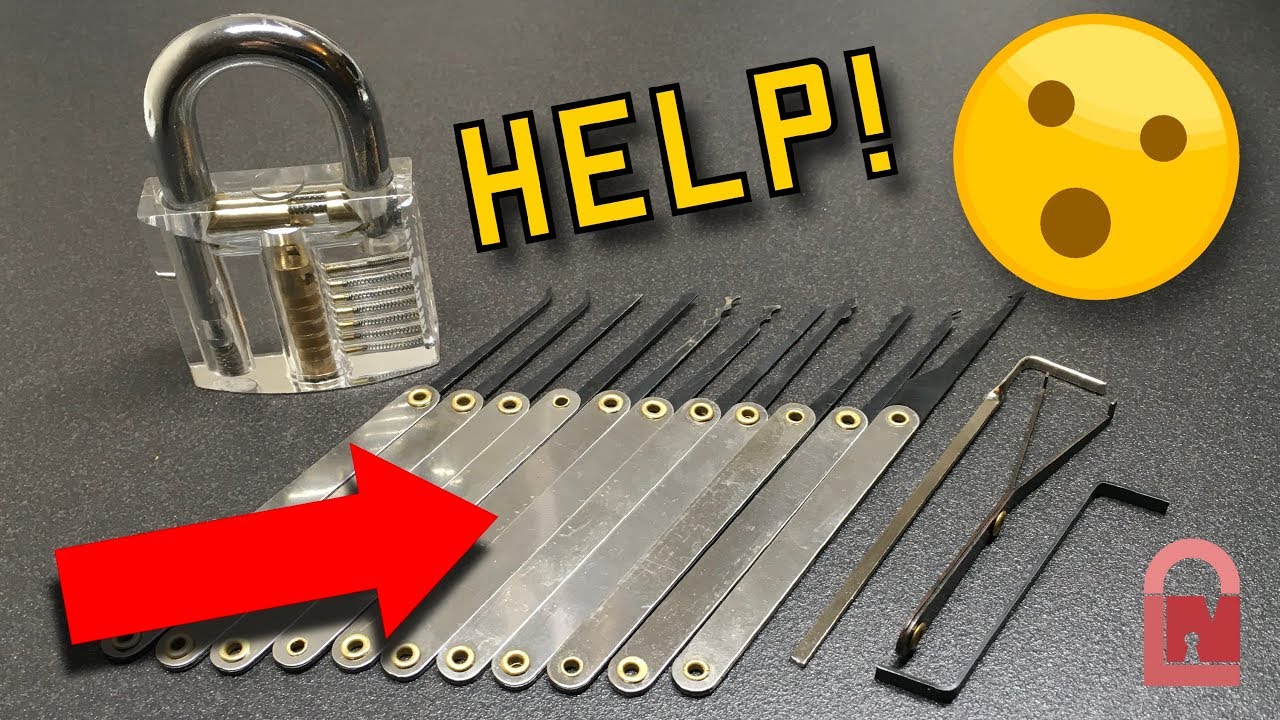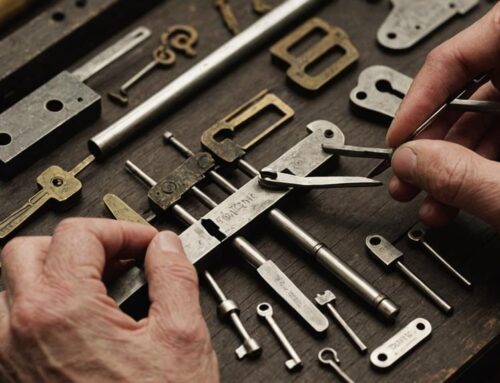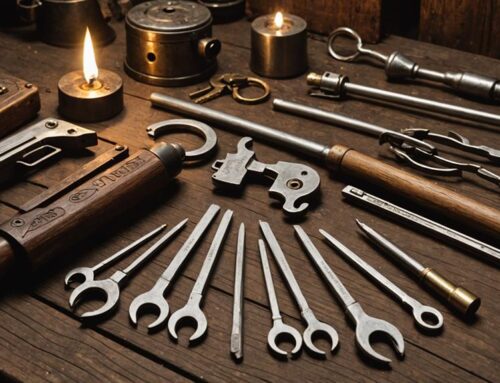Think lockpicking’s just for thieves? Think again! You’re about to immerse yourself in the fascinating world of locksmithing. We’ll guide you through the intricate craft of defeating locks using everyday items and professional tools. You’ll learn, you’ll practice, and soon you’ll master this unique skill. Remember, we’re not promoting illegal activities, but empowering you with knowledge. So, ready to unlock your potential? Let’s dive in!
Key Takeaways
- Lockpicking is a skill used to open locks without a key.
- It can be done with professional or improvised tools.
- The goal is to manipulate the lock’s components to unlock it.
- It requires practice and patience to master.
The Basics of Lockpicking: An Overview
You’ll need a good understanding of the basics of lockpicking, including how to use common items like bobby pins and paperclips, to manipulate the various components of a lock. It’s crucial to know that while exploring this skill, the legality of lockpicking must always be respected. You’re now part of a community that values trust and integrity.
Learning the mechanisms of common locks, you’ll grasp how a pin tumbler lock functions. You’ll understand the roles of the key pin, driver pin, and shear line in the unlocking process. With practice, you’ll gain the ability to feel the slight movements within the lock, guiding your tools to unlock the secrets held within. Remember, your new knowledge is a skill, not a weapon. Use it wisely and responsibly.
Understanding the Tools of the Trade
In this section, we’re diving into the tools of the trade, and you’ll discover how to transform everyday objects into effective lockpicking devices. You’ll grasp the anatomy of different types of locks and their vulnerabilities. By understanding the lock’s structure, you’ll be better equipped to exploit its weaknesses. Bobby pins and paperclips are your friends here, ideal for crafting picks and tension wrenches. Remember, it’s all about finesse, not force. A common mistake to avoid in lockpicking is applying too much pressure which can result in broken tools or damaged locks. Practice makes perfect, so take your time, be patient, and soon you’ll start feeling like you truly belong to the community of skilled lockpickers.
The Bobby Pin Method: A Comprehensive Guide
While you’re grasping the basics of lockpicking, it’s crucial to understand the bobby pin method fully, as it’s one of the simplest yet most effective techniques you can use. Here’s a quick rundown:
| Step | Action | Outcome |
|---|---|---|
| 1 | Remove rubber tip | A metal shaft remains |
| 2 | Straighten the pin | Creates your pick |
| 3 | Create a 45-degree hook | Improves lock manipulation |
| 4 | Bend second pin into an ‘L’ | Forms your tension wrench |
You’re now ready to tackle different types of locks for lockpicking. But remember, respect the legality of lockpicking. It’s a tool, not a license for illicit activities. Your new skills should be for personal use, like unlocking a forgotten padlock. Welcome to the lockpicking community. You’re one of us now, and there’s always more to learn.
Mastering the Art of the 45-Degree Hook
Someone might think it’s tricky, but once you’ve got the hang of it, making a 45-degree hook for lockpicking isn’t as tough as it seems. As you delve into exploring different lockpicking techniques, you’ll find the hook is crucial for mastering advanced lock manipulation techniques.
Firstly, grab your bobby pin or paperclip. Straighten it out, leaving just enough curve to comfortably hold. Now, use your pliers to create a 45-degree bend at one end. This hook becomes your lock’s worst nightmare, expertly maneuvering its way around internal pins.
The Importance of a Good Tension Wrench
You can’t underestimate the importance of a good tension wrench, for it’s an essential tool that helps apply the right amount of pressure to the lock, and without it, you’d struggle to pick even the simplest locks. It’s more than just a tool, it’s your gateway to mastering the art of lockpicking. The role of tension in lockpicking is paramount; too little and the pins won’t set, too much and they’ll bind. But with the right tension wrench and the understanding of the importance of proper technique, you’re already halfway there. Remember, the tension wrench is your constant, your anchor in the storm of the lock’s internals. Welcome to this community, where we value skill and precision. You’re not just picking locks, you’re unlocking a new part of yourself.
The Paperclip Technique: Unlocking With Ease
The Paperclip Technique, as the name suggests, is an incredibly simple yet effective method that you’ll find perfect for practicing your lockpicking skills. It’s a popular alternative to the bobby pin pick, suited for those looking to master the art of lockpicking.
Here’s a brief rundown:
- Unfold the paperclip into a straight wire.
- Make a small bend at one end. This is your pick.
- Use another paperclip as your tension wrench by bending it into an ‘L’ shape.
- Insert the tension wrench, apply slight pressure, and manipulate the pins with your paperclip pick.
But beware of common lockpicking mistakes such as applying too much pressure or not being patient. Remember, practice makes perfect. You’re now part of the lockpicking community. Happy picking!
Strengthening Your Paperclip for Maximum Effect
By twisting the inner end around, it’s possible to make your paperclip pick much more sturdy and efficient. This strengthening technique’s crucial to the lockpicking process. You want to wrap the inner end of the paperclip around the straight section using pliers or your fingers, making your tool more reliable. Now, a common mistake is skipping this step, resulting in a weaker pick that’s harder to manage. But you’re not one to cut corners. You’re part of a community that values skill and precision. So, take your time with this. The patience you show here will pay off when your strengthened paperclip easily manipulates the lock’s components. Remember, every step you take to improve your tool brings you closer to mastering the art of lockpicking.
Exploring Alternative Lockpicking Methods
In addition to the bobby pin and paperclip methods, we’re delving into alternative lockpicking techniques, and you’ll find that with the right tools and technique, virtually any lock can be conquered. As we’re exploring lockpicking ethics, remember, these techniques should be used responsibly and legally.
Here are a few advanced lockpicking techniques:
- Bump Keys: By inserting a specially cut key into the lock and applying a sharp impact, the lock pins can be momentarily jarred into the correct position to turn the lock.
- Lockpicking Guns: These mechanical devices mimic the action of a key being inserted and turned.
- Impressioning: This technique involves creating a working key for the lock, usually with a blank key and some careful filing.
- Decoding: It includes the use of tools designed to read the internal components of a lock and deduce the correct key cuttings.
The Art of Making Your Own Lockpick
You’re diving into the art of making your own lockpick, a skill that’s both fascinating and practical, but remember, it’s essential to use this knowledge responsibly and not for any illegal activities.
Crafting lockpicks from household items like bobby pins and paperclips can be a thrilling experience.
Let’s dig into the details:
| Steps | Bobby Pin | Paperclip |
|---|---|---|
| 1 | Remove rubber tip | Straighten outermost bend |
| 2 | Straighten the pin | Twist the inner end |
| 3 | Create a 45-degree hook | Make a 45-degree bend |
| 4 | Bend second pin into L shape | Unfold second clip into U shape |
| 5 | First pin for picking, second for tension | Use as pick and tension wrench |
Always remember the ethics of lockpicking, you’re doing this to enhance your skills, not for unlawful activities.
Crafting the Perfect Tension Wrench: A Step-by-Step Guide
Often, you’ll find that crafting the perfect tension wrench is a crucial step in becoming proficient at lockpicking. The tension wrench is your key to control, and its design can significantly impact your success. Exploring different tensioning techniques opens the door to improved lockpicking accuracy. Here’s your guide:
- Choose Your Material: Items like bobby pins or paperclips work well.
- Create the Bend: A right angle is standard, but explore other angles for different locks.
- Test the Tension: Practice on a variety of locks to get a feel for the right amount of pressure.
- Refine Your Technique: As you get more comfortable, you’ll find your own nuances to improve accuracy.
Frequently Asked Questions
What Are Some Safety Precautions to Take When Practicing Lockpicking?
While practicing lockpicking, always use pick-proof locks. Wear protective equipment to prevent injuries. Remember, it’s not just about skill, it’s about safety too. You’re part of a community that values both expertise and caution.
How Long Does It Typically Take to Master the Skill of Lockpicking?
Mastering lockpicking takes time; there’s no set timeline. It’s all about your patience and the effort you put into practicing different picking techniques. Just keep at it, you’re part of a skilled and exclusive community.
Can Lockpicking Damage the Lock and How Can This Be Prevented?
Yes, lockpicking can damage the lock if not done carefully. To prevent this, ensure proper lock maintenance and be selective with your picks. Careful and gentle maneuvers won’t harm the internal mechanisms.
Are There Specific Types of Locks That Are Easier or More Difficult to Pick?
Yes, some locks are easier to pick than others. Basic pin tumbler locks are generally simpler to pick, while high-security locks require advanced techniques. It’s about understanding lock types and picking techniques.
Is It Legal to Carry Lockpicking Tools in Public?
You’re curious if carrying lockpicking tools in public is legal. This depends on local laws. Some places view tool acquisition as intent for unlawful use. Always research legal implications in your area to stay informed.









